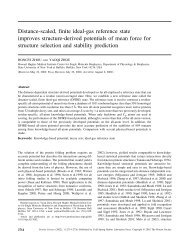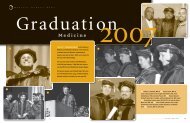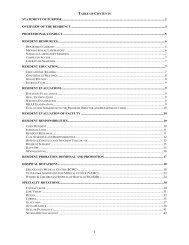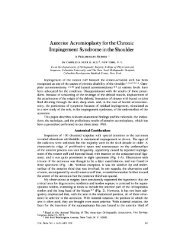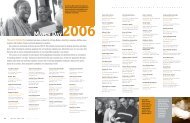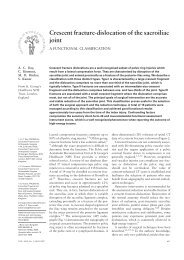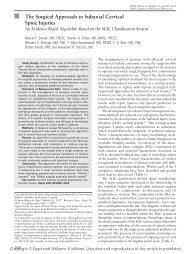Secondary Chondrosarcoma
Secondary Chondrosarcoma
Secondary Chondrosarcoma
You also want an ePaper? Increase the reach of your titles
YUMPU automatically turns print PDFs into web optimized ePapers that Google loves.
Patrick P. Lin, MD, et al<br />
undergo malignant transformation.<br />
Plain radiography may not demonstrate<br />
the cartilage cap as well as either<br />
CT or MRI do, which may lead<br />
the unwary clinician to underestimate<br />
the true size of the cap.<br />
Osteochondromas may have the<br />
appearance of an enlarged cartilage<br />
cap on T2-weighted magnetic resonance<br />
images when there is a large<br />
bursa around the cap. The fluid<br />
within the bursa appears similar to<br />
that of cartilage tissue because both<br />
entities have high water content.<br />
Gadolinium contrast is used to distinguish<br />
bursal structures from true<br />
cartilage tissue. The bursas have only<br />
rim enhancement of the bursal tissue<br />
without contrast enhancement of the<br />
fluid inside the bursa.<br />
Many clinicians believe that a cartilage<br />
cap with a thickness of 2 cm seems to be<br />
strong evidence for the presence of<br />
secondary chondrosarcoma.<br />
Some authors have stressed the importance<br />
of the character of the cartilage<br />
cap in addition to its absolute<br />
size. Ahmed et al 4 stated that “a<br />
qualitative assessment of the cartilaginous<br />
cap was more helpful than a<br />
precise measurement of cap thickness.”<br />
Irregularity of the surface of<br />
the cartilage cap correlated with the<br />
fuzzy appearance of the lesions on<br />
radiographs; this irregularity may reflect<br />
an increased invasive nature of<br />
the lesion.<br />
Pathology<br />
The diagnosis of secondary chondrosarcoma<br />
is confirmed by histologic<br />
examination of biopsy samples. Like<br />
conventional chondrosarcoma, secondary<br />
chondrosarcoma is not always<br />
easy to diagnose, and the histologic<br />
features alone may not be<br />
sufficient to determine that a lesion<br />
has become malignant. Most secondary<br />
chondrosarcomas are low grade.<br />
The overlap in appearance between<br />
benign lesions and low-grade cartilage<br />
tumors has led to a high rate of<br />
inter- and intraobserver variability in<br />
diagnosis. 24 Critical information<br />
from the clinical history and imaging<br />
studies must be correlated with the<br />
pathologic data to render the correct<br />
diagnosis.<br />
On the pathology slides, sarcomatous<br />
transformation is usually identified<br />
by the presence of malignant<br />
chondroid tissue. Hallmarks include<br />
hypercellularity, binucleate cells,<br />
multiple cells in lacunae, atypical nuclei,<br />
and myxoid changes in the hyaline<br />
cartilage matrix (Figure 2).<br />
Thickening of the cartilage cap can<br />
be observed grossly. 23<br />
A few abnormal features may<br />
make it difficult to distinguish the<br />
cartilage of osteochondromas from<br />
low-grade chondrosarcomas on the<br />
basis of histologic findings alone,<br />
even for experienced pathologists. 25,26<br />
There may be mild nuclear atypia,<br />
slight hypercellularity, and occasional<br />
binucleate cells. In these cases,<br />
the radiographic and clinical findings<br />
are important. 27 A lesion with a thin<br />
cartilage cap that has not grown or<br />
changed for years is unlikely to have<br />
transformed into a malignant tumor.<br />
Conversely, sudden growth in a cap<br />
with marked enlargement of the cap<br />
strongly suggests the presence of<br />
chondrosarcoma, even when the histologic<br />
findings show minimal abnormalities<br />
that would be compatible<br />
only with a diagnosis of grade 1<br />
chondrosarcoma (low grade).<br />
An important feature consistent<br />
with malignancy is permeative infiltration<br />
of soft tissues and the presence<br />
of discrete nodules of cartilage<br />
in the soft tissues separated from the<br />
main tumor mass. In one study, 57%<br />
of all cases of secondary chondrosarcoma<br />
showed histologic evidence of<br />
such permeative changes on the pathology<br />
slides. 4 Medullary extension<br />
of cartilaginous tumor into bone also<br />
demonstrates invasive and malignant<br />
behavior. This may be found in up to<br />
one third of cases, and it tends to be<br />
more common in broad-based osteochondromas.<br />
13<br />
The grading of secondary chondrosarcomas<br />
is similar to that of primary<br />
chondrosarcomas and includes<br />
grade 1, low; grade 2, intermediate;<br />
and grade 3, high. 14,28 In general, increasing<br />
grade is associated with<br />
greater cellularity, number of binucleate<br />
cells, and mitoses.<br />
Most secondary chondrosarcomas<br />
are grade 1 or 2 lesions. In the pub-<br />
October 2010, Vol 18, No 10 611




